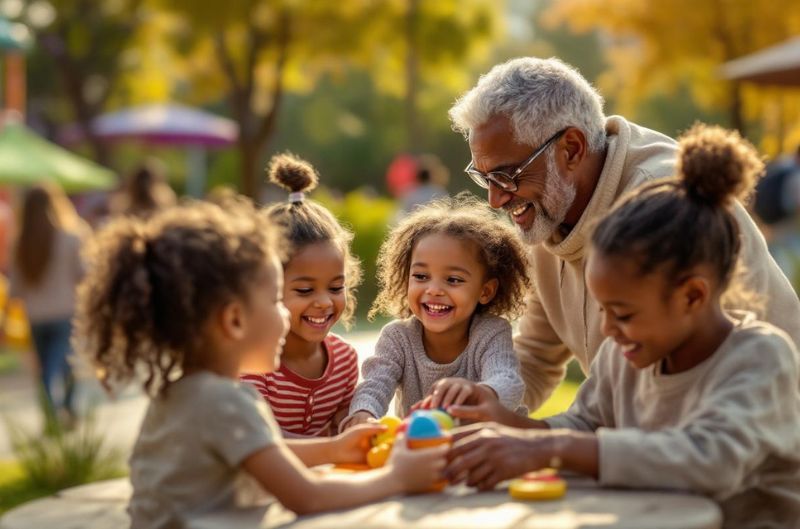
Lifelong Play: How Parks and Recreation Strengthens Generational Ties
Author: Austin Stanfel
Parks have long served as social cornerstones, green spaces where laughter, movement, and shared experience spill across generations. In an era often defined by digital divides and fast-paced routines, public parks and recreation programs remain powerful equalizers. They invite children, parents, grandparents, and neighbors alike to pause, gather, and play together.
The Intergenerational Heart of Public Parks
A well-designed park is more than a landscape; it is a meeting ground. Here, toddlers chase bubbles on the lawn while nearby, older adults stretch through morning tai chi sessions. Teenagers share basketball courts with community volunteers, and families gather under picnic shelters for reunions that blend stories, recipes, and laughter from multiple eras.
These interactions help bridge the widening generational gap. Shared activities, whether a hike, a summer movie night, or community gardening- build respect between age groups, strengthen empathy, and sustain cultural continuity. For many older adults, participation offers purpose and belonging, while for children, it models collaboration, patience, and care for others.
Recreation Programming as a Connector
Municipal recreation departments play an essential role in intentionally bringing generations together. Programs designed around inclusivity and flexibility allow everyone to engage at their own level. Examples include:
- Family-friendly sports leagues where kids and adults form mixed-age teams.
- Intergenerational art workshops teaching traditional crafts alongside digital design.
- Outdoor fitness or dance classes for all ages, encouraging cross-generational motivation.
- Community gardens where elders pass down planting wisdom to young volunteers.
When local governments invest in recreational programming that appeals broadly, participation rises. Parks transform from passive green spaces to living community hubs of shared energy.
Design Matters: Creating Spaces for All Ages
The physical layout of parks profoundly influences how generations interact. Features that accommodate multiple age groups naturally foster connection. Designers increasingly consider intergenerational use alongside safety, comfort, and accessibility. Elements that promote this include:
- Playgrounds with adult-friendly fitness zones beside children’s areas.
- Comfortable seating clusters near playgrounds where grandparents can watch and engage.
- Wide, accessible paths supporting strollers, wheelchairs, and walkers together.
- Shade structures, restrooms, and gathering shelters make extended family visits enjoyable.
Designing for intergenerational use also extends to programming the landscape for shared events, such as outdoor concerts, book fairs, or cultural festivals, where people of all ages feel invited to participate, not just attend.
Strengthening Mental and Social Health
The social, emotional, and physical benefits of intergenerational recreation are deeply rooted in wellness science. Regular exposure to nature reduces anxiety, lowers blood pressure, and improves cognitive performance for all ages. However, the social dimension multiplies those benefits.
Children gain emotional security and a sense of rootedness when they connect with older generations. Teenagers who volunteer in recreation programs often report higher empathy and leadership skills. Meanwhile, older adults remain more active and mentally sharp when engaged in youth- and community-based activities.
These connections form a subtle but vital social infrastructure, one that contributes not only to individual health but to civic resilience. Parks that invite generations to mingle strengthen the fabric of community life, combating isolation and nurturing shared identity.
Reimagining Parks as Lifelong Learning Spaces
Forward-thinking communities are expanding the definition of recreation beyond play and exercise to include learning and mentorship. Intergenerational programs, like environmental stewardship projects, storytelling circles, and arts collaborations, turn parks into open-air classrooms.
For example, some cities organize “adopt-a-park” initiatives where local seniors mentor teens in park maintenance, horticulture, or historical preservation. Others host seasonal camps pairing older volunteers with youth to explore nature, science, and local heritage. These initiatives not only transfer knowledge but also celebrate the wisdom within every age group.
Building a Legacy of Connection
When parks and recreation become threads that weave together communities across generations, the effect lasts far beyond a single event. Young children grow up with cherished memories of grandparents at the playground. Adults rediscover play as a shared joy, not just a childhood phase. Seniors remain vital participants in the pulse of local life.
Every bench conversation, shared garden harvest, or multigenerational dance class becomes part of a living legacy, a reminder that while time separates generations, play and public spaces unite them.

